Whartonites no longer have to make their way to Van Pelt to print for eight cents per page.
Last December, Wharton computing labs lowered their price from 10 cents per page for black-and-white printing to meet the level charged at libraries and other locations on campus.
And some students are trying to make printing even cheaper.
College freshman and Undergraduate Assembly representative Leila Decker is currently working on a printing policy update for the Undergraduate Assembly that proposes creating and giving students a set amount of "printing dollars."
She pointed to a recent survey conducted by the UA which revealed that students spend an average of $8 per year on printing from external locations.
"[Printing] is a resource the University should help fund in some way," Decker said.
But a standardized printing plan for students might not be as close as some hope.
Because Information Technology at Penn is so decentralized, there is a discrepancy in printing prices and policies across different facilities. This situation arises because they all have different cost models and different ways of recovering their costs, Wharton Information Technology Director David Comroe said.
Computing support is shared by the 12 schools, Penn's business units and the Office of Information Systems and Computing. Therefore, each school sets its own policies and prices regarding printing.
The Engineering school offers five pages per day of free printing for its students at its labs and Nursing students have $25 dollars of in-school printing credit per year. Wharton students receive a one-time five dollar quota of printing credit for use in Huntsman Hall.
The College - where the majority of Penn undergraduates reside - is the only school that does not provide any sort of school-exclusive pre-paid printing privileges.
"The logistics for doing that at SAS are far more complicated," because College students do not have school-specific computer log-in accounts, College director for instructional technology John MacDermott said.
The administrative costs required to create an infrastructure that would differentiate SAS students from their peers would be too high, he added.
But around the country, numerous universities allow students to print at no cost. Princeton University and Dartmouth College both provide unlimited gratuitous printing to their students, Decker said.
Neither school returned requests for comment on how such a system was implemented.
In order to implement such a system, funding is the crucial issue - especially for a school as large as Penn.
"The size of the student body is so overwhelming," Decker said, which is why free printing may not be a feasible option.
And according to Comroe, even at eight cents per page, Wharton is already subsidizing the cost of printing.
Aside from the need to cover the costs, computing administrators cited another reason for the impracticality of such generous printing policies. They say that students may print irresponsibly, leading to both unnecessary waste and environmental problems.








